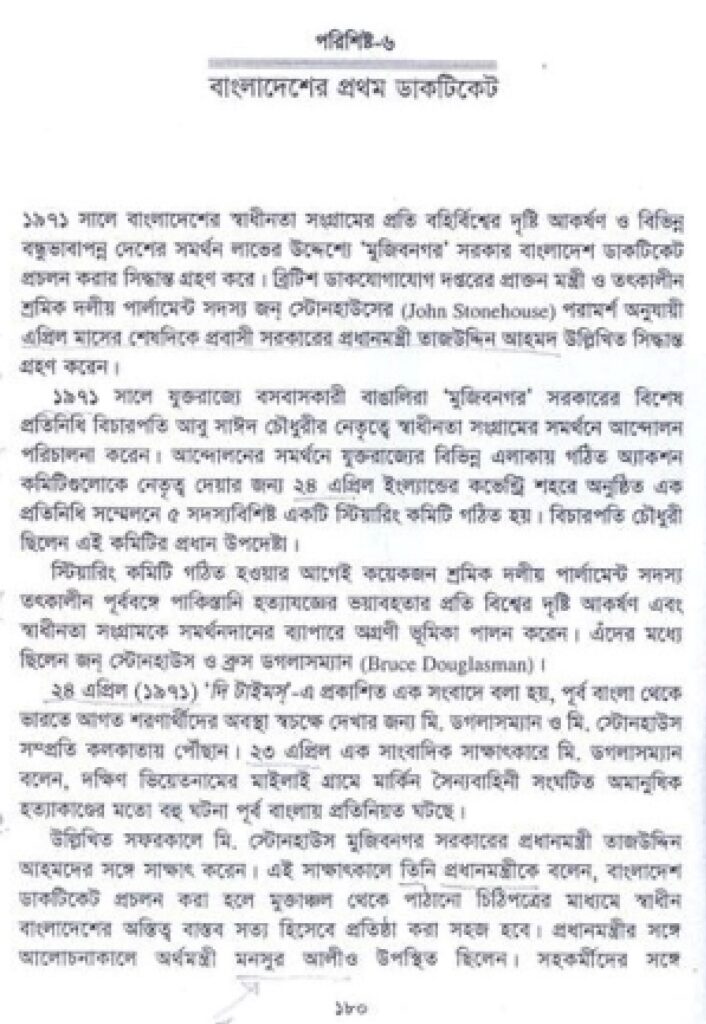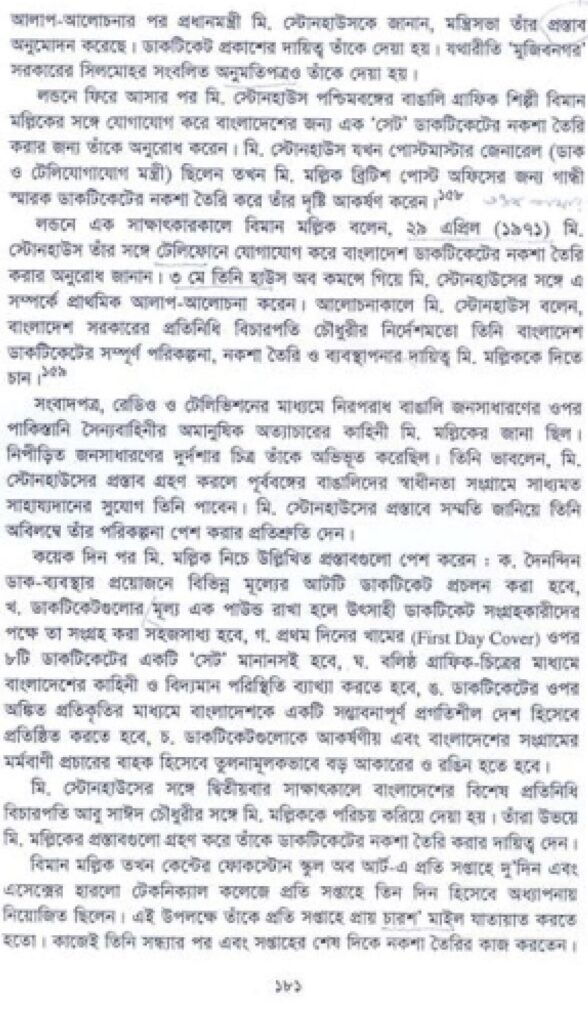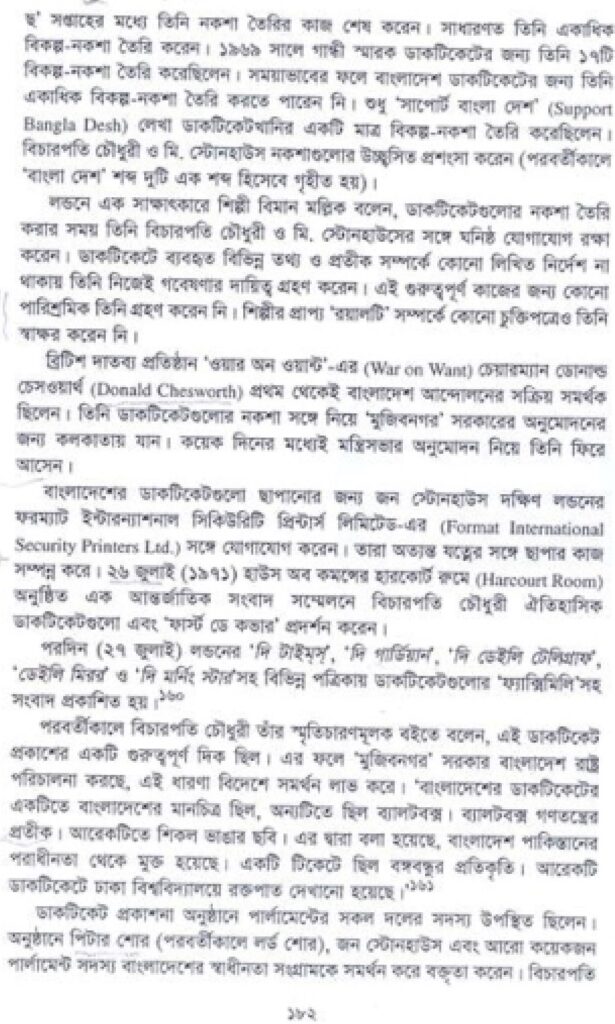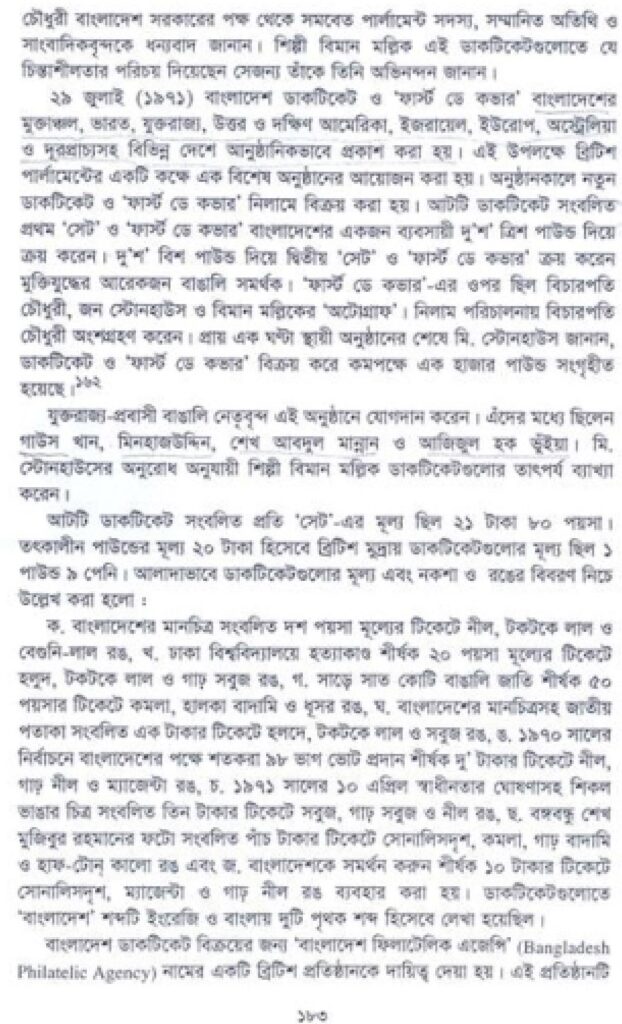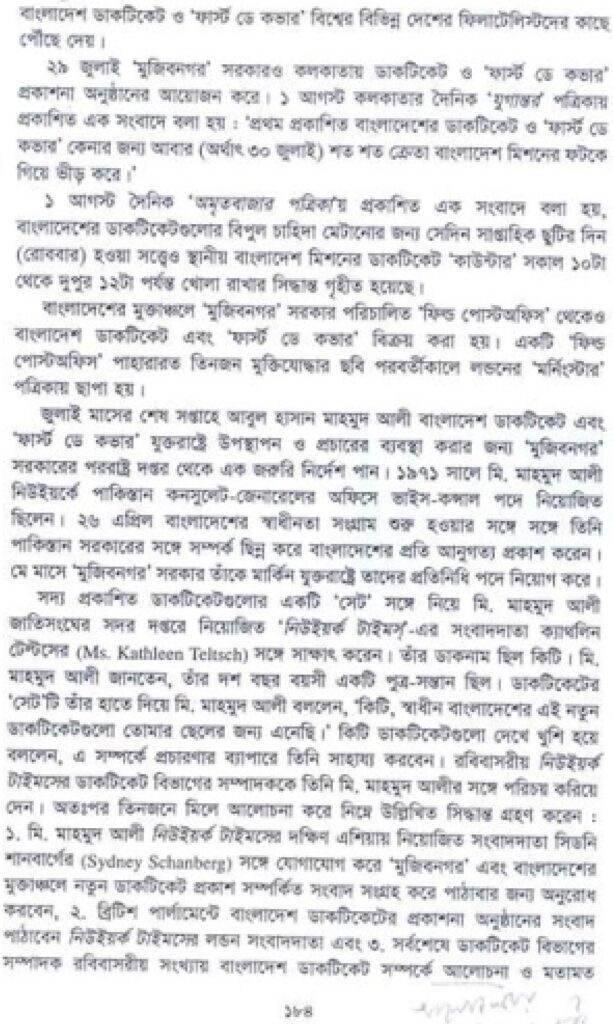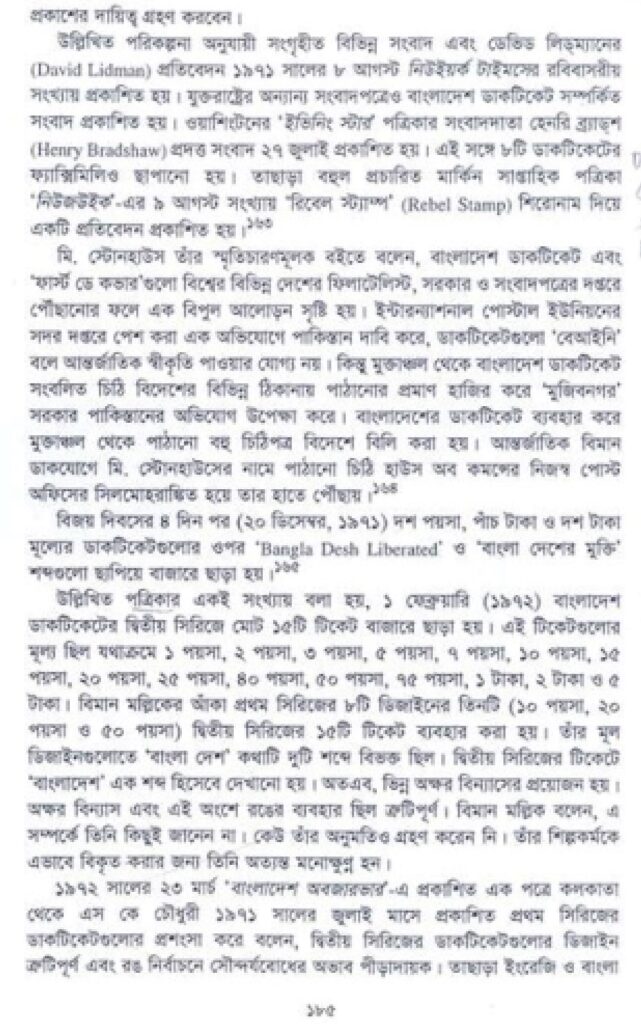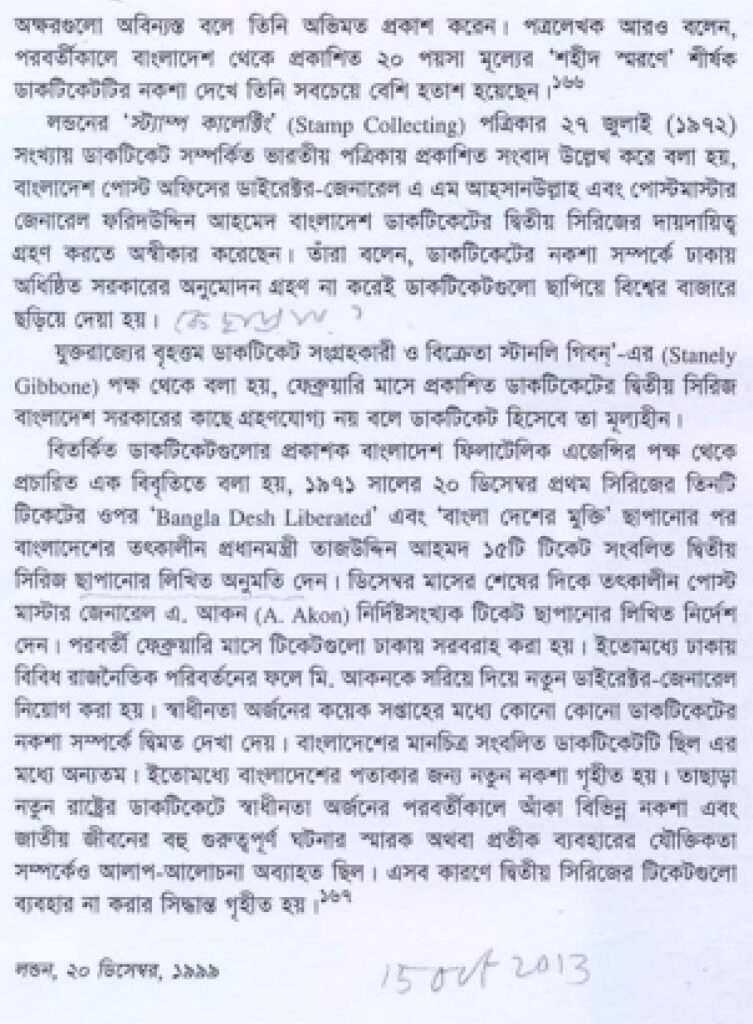“The First Eight Stamps of Bangladesh” by Abdul Matin
(The translation is edited to suit the present readership.)
The fledgling ‘Mujibnagar’ Government decided to issue Bangladesh stamps in order to draw the attention of the rest of the world to the Liberation Movement of Bangladesh in 1971 as well as to gain support from various countries with whom Bangladesh had a friendly relationship. Mr. Tazuddin Ahmed, the Prime Minister of the then government, took the above-mentioned decision towards the end of the month of April according to the suggestion of Mr. John Stonehouse, a member of the British Parliament from the British Labor Party. He was the Minister (1 July 1968 - 1 October 1969) in Charge of Post and Telecommunication in the previous British government under the British Labor party. During the Freedom movement of Bangladesh the British Government was under the control of Conservative Party.
In the year 1971, most Bengalis, who were then living in the United Kingdom, supported the Liberation War through the leadership of Justice Abu Sayed Chowdhury, the special representative of the ‘Mujibnagar’ Government. In order to support the movement, a Steering Committee with 5 members was founded during a conference of the representatives that took place in the city of Coventry in England on 24th April which led various action committees founded in different cities of England. Justice Chowdhury was the Chief Advisor of this Committee.
Even before founding the Steering Committee, some parliamentary members of the Labor Party played a prominent role in drawing the attention of the whole world towards the brutality of the ongoing mass genocide by the Pakistani Army in the then East Pakistan and in gaining support in favor of the Liberation War. Mr. John Stonehouse and Mr. Bruce Douglasman were among these people.
On 24 April, 1971 “The Times” published a report which said Mr. Douglasman and Mr. Stonehouse had recently arrived at Calcutta to see the situation of the refugees, who have come from East Pakistan to India, with their own eyes. On 23 April in an interview with journalists Mr. Douglasman said that like the slaughter that was perpetrated by the U.S. Army in the village of My Lai in South Vietnam, many incidents of such inhuman killing were daily occurring in East Pakistan.
During the tour, Mr. Stonehouse met Mr. Tazuddin Ahmed, the Prime Minister of the Mujibnagar Government. In the course of the meeting, he said to the Prime Minister that, if postage stamps are issued in Bangladesh, proving the existence of the independent Bangladesh would be easier through letters that were sent from independent countries. The Finance Minister, Mr. Monsur Ali, was also present there during this discussion with the Prime Minister. After conversing with fellow colleagues the Prime Minister advised Mr. Stonehouse that the Cabinet had approved his proposal. He was also provided with the approval letter containing the seal of the ‘Mujibnagar’ Government, as per the usual custom.
After returning to London, Mr. Stonehouse contacted Mr. Biman Mullick, a Bengali graphic artist from West Bengal, and asked him to design a ‘set’ of stamps for Bangladesh. Mr. Mullick had designed the ‘Gandhi Centenary Year 1969’ stamp for the British Post Office while Mr. Stonehouse was the Postmaster General (Minister in Charge of Post and Telecommunications) and Mr. Mullick had drawn his attention.
While giving an interview in London Mr. Biman Mullick said that on 29 April (1971) Mr. Stonehouse contacted him through telephone and asked him to design the stamps for Bangladesh. On 3 May he went to the House of Commons and discussed the primary steps with Mr. Stonehouse. During the discussion Mr. Stonehouse stated that according to the instructions of Justice Chowdhury, the representative of the Bangladesh Government, he wanted to assign the entire responsibility of the planning, development of designs and management of the stamps of Bangladesh to Mr. Mullick.
Mr. Mullick expressed his feelings about the atrocities of the Pakistani Army on innocent Bengali people since he had been reading newspapers, listening to the radio and watching television. He was deeply moved by the sufferings of the oppressed population. He understood that if he accepted Mr. Stonehouse’s proposal, he’d get the chance to do his best to help with the Liberation War of the Bengalis of East Bengal. He agreed with Mr. Stonehouse’s proposal and assured him he would deliver his drafts as soon as possible.
After a few days Mr. Mullick presented his draft designs along with detailed notes of explanation included below:
While visiting Mr. Stonehouse for the second time, Mr. Mullick was introduced to Justice Abu Sayed Chowdhury, the special ambassador of Bangladesh. Both of them accepted Mr. Mullick’s proposals and assigned him the task of creating stamp designs for Bangladesh.
At that time, Biman Mullick was employed as a visiting lecturer at the Folkstone School of Art in Kent for two days a week and for the other three days a week at Harlow Technical College in Essex. For this reason, he had to travel almost 400 miles per week. That’s why he used to work on the designs every day in the evening and on weekends. He finished the task of creating the designs within six weeks. Usually, he created more than one alternative design. For example, in 1969, he had created 17 alternative designs while creating the Gandhi Centenary Stamp. Since time was of the essence, he could not create any alternative designs for the stamps of Bangladesh. He created only one alternative design for the single stamp in this whole set - Support Bangla Desh. Justice Chowdhury and Mr. Stonehouse both praised all these designs very generously. (Later, the two words ‘Bangla Desh’ were accepted as one single word).
During an interview in London, Mr. Biman Mullick said while creating the stamps, he kept in close contact with Justice Chowdhury and Mr. Stonehouse. Since there weren’t any written guidelines about how the stamps were to be designed he himself took the responsibility of doing all the research work. He took no remuneration for doing this immensely important work. He didn’t even sign any contract paper regarding the ‘royalty’ that an artist is supposed to receive.
Donald Chesworth, the Chairman of ‘War on Want’, a British charitable organization, was a supporter of the Bangladesh independence movement since the very beginning. He took the proposed designs with him and went to Calcutta in order to obtain the approval of the ‘Mujibnagar’ Government. Within a few days he came back with the approvals of the Cabinet. (Mujibnagar means the city of Sheikh Mujibur Rahman).
In order to print the stamps of Bangladesh, Mr. John Stonehouse contacted Format International Security Printers Ltd., located in South London. They undertook the task of printing these stamps with much care and responsibility. On 26 July, 1971, Justice Chowdhury launched these historic stamps as well as their ‘First Day Covers’ at an international press conference organized at the Harcourt Room of the Houses of Parliament in London.
On the next day (27 July), various international newspapers such as London’s ‘The Times’, ‘The Guardian’, ‘The Daily Telegraph’, ‘Daily Mirror’ and ‘The Morning Star’ published this news along with the facsimiles of these stamps.
Later, Justice Chowdhury wrote in the book of his recollections called ‘Probase MuktiJuddher DinGuli’ meaning ‘My Days Abroad During the Liberation War’, that launching of these stamps had a vital point. Because of these stamps, the concept that the Mujibnagar Government was governing the state of Bangladesh got international attention. “In the stamps of Bangladesh, one contained the picture of Bangladesh’s map; another contained a picture of a ballot box. A ballot box symbolizes democracy. Another stamp contained the picture of breaking shackles. Through this the message the idea that circulates is that Bangladesh has become free from the subjection of Pakistan. One of these stamps contained the portrait of Bangabandhu. Another one showed bloodshed that occurred in Dhaka University.”
Members from every parliamentary party were present in the inauguration program of these stamps. In this program, various parliamentary members such as Mr. Peter Shore (Lord Shore later), Mr. John Stonehouse and some others gave speeches supporting the Liberation Movement of Bangladesh. On behalf of the Bangladesh Government Justice Chowdhury cordially thanked the gathered parliament members, honorable guests and all the reporters. He congratulated Mr. Biman Mullick since he had shown great insight while creating these postal stamps.
On 29 July (1971) the Bangladeshi Stamps and ‘First Day Cover’ were officially published in various countries all over the world, including the independent Bangladesh, India, United Kingdom, North and South America, Israel, Europe, Australia and the Far East. For this a special event was organized in one of the chambers of the British Parliament. The new stamps and the ‘First Day Covers’ were sold in an auction here during this event. The First Set containing eight postal stamps as well as the ‘First Day Cover’ was bought by a Bangladeshi businessman that cost £230. Another Bengali supporter of the Liberation War bought the Second Set and the ‘First Day Cover’ with £220. The front of the ‘First Day Cover’ contained the autographs of Justice Chowdhury, Mr. John Stonehouse and Mr. Biman Mullick. Justice Chowdhury conducted the entire auction. After the event was finished, which continued for almost one hour, Mr. Stonehouse informed everyone that at least £1000 had been collected by selling the stamps and the ‘First Day Covers’.
The UK expatriates and Bengali political leaders who joined this event were Mr. Gaus Khan, Mr. Minhazuddin, Mr. Sheikh Abdul Mannan Bhuiyan and Mr. Azizul Haque Bhuiyan among others. Following Mr. Stonehouse’s request, Mr. Biman Mullick explained the significance of these stamps to all.
Each of the sets, containing eight postal stamps, cost 21 taka 80 paisa. According to the value of the pound during that time, which was 20 taka per pound, these postal stamps cost 1 pound 9 pennies in the British rate. The prices, designs and color descriptions of these stamps are described separately below:
- The stamp containing the picture of the Bangladeshi map priced 10 paisa contained the colors blue, bright red and purple,
- The stamp containing the image of the massacre that occurred in Dhaka University was priced at 20 paisa and contained the colors yellow, bright red and deep green,
- The stamp with the title ‘A NATION OF 75 MILLION PEOPLE’ was priced at 50 paisa and had the colors orange, light brown and grey,
- The stamp containing the picture of the national flag of Bangladesh along with the geographical map of the country was priced at one taka and had the colors yellow, bright red and green,
- The stamp with the theme regarding the election of the year 1970 where 98% votes were cast in favor of Bangladesh, was in two shades of blue and red and cost two taka,
- The stamps with the image of breaking shackles along with the declaration of independence on 10th April of 1971 contained the colors green, deep green and blue and cost three taka,
- The stamp that contained the photograph of Bangabandhu Sheikh Mujibur Rahman had simulated gold, orange, deep brown and half-tone black and was priced at five taka, and
- The stamp with the slogan ‘SUPPORT BANGLA DESH’ cost ten taka each and contained colors such as golden, magenta and deep blue. In each of these stamps the words ‘Bangla Desh’ had been written in both English and Bengali as two different words.
The responsibility of selling the stamps of Bangladesh had been given to a British company called the Bangladesh Philatelic Agency. This company distributed the stamps and the ‘First Day Cover’ of Bangladesh to the philatelists of various countries all over the globe.
On 29th July the Mujibnagar Government also arranged a program for the inauguration of the stamps and the ‘First Day Cover’ of these stamps in Calcutta. On 1st August “The Daily Jugantar’ of Calcutta published a news article where it said: “In order to buy the Bangladeshi stamps and the ‘First Day Cover’, hundreds of customers gathered again (which means 30th July) in front of the gate of the Bangladesh Mission.”
On 1st August a report published in “The Daily Amrita Bazar Patrika” stated that although it was a weekly holiday (Sunday), in order to fulfill the huge demand of the stamps of Bangladesh, the stamp counter of the local Bangladesh Mission had to be kept open from 10 am to 12 pm.
The stamps of Bangladesh as well as the ‘First Day Covers’ were also sold from the ‘Field Post Office” of the independent part of Bangladesh, which sale was conducted by the Mujibnagar Government. Later a picture of three freedom fighters who were guarding the Field Post office was published in an issue of London’s daily, ‘The Morning Star’.
In the last week of July, Mr. Abul Hasan Mahmood Ali received an important order from the Ministry of External Affairs of the Mujibnagar Government to arrange the introduction and promotion of the Bangladeshi stamps in the United States of America. In 1971, Mr. Mahmood Ali was employed as the Vice Consul at the Pakistan Consulate General’s office situated in New York. On 26 April, as soon as the liberation war of Bangladesh started, he immediately discarded all sorts of relations with the Pakistan government and showed alliance towards Bangladesh. In the month of May, the Mujibnagar Government employed him as their representative in the United States of America.
With a set of the newly inaugurated stamps, Mr. Mahmood Ali visited Ms. Kathleen Teltsch, a reporter of ‘The New York Times’, who was then employed at the head office of the United Nations. Her nickname was Kitty. Mr. Mahmood Ali knew that she had a son who was 10 years old. Giving the set of stamps in her hand, Mr. Mahmood Ali said to her, “Kitty, I’ve brought these new stamps of the independent Bangladesh for your son.” Kitty was happy to see the stamps and said that she would help with the promotion of them. She introduced the editor of the stamps section of ‘The New York Times’ (Sunday special) to Mr. Mahmood Ali. After that, the trio conversed and decided the following:
- Mr. Mahmood Ali would contact Mr. Sydney Schanberg, the reporter of ‘The New York Times’ employed in South Asia, and make a request that he collect and send the news associated with the inauguration of the new stamps in ‘Mujibnagar’ and the independent Bangladesh,
- The London correspondent of ‘The New York Times’ would send the news of the inauguration of Bangladeshi stamps in the British Parliament,
- Finally, the editor of the stamps section would take the responsibility of publishing the discussion and opinions regarding the stamps of Bangladesh in the Sunday edition.
On 8th August, 1971, according to the mentioned strategies, various collected news stories and the report made by David Lidman were published in the Sunday edition of ‘The New York Times’. Other American newspapers also published the news about the stamps of Bangladesh. The news report of reporter Henry Bradshaw from ‘The Evening Star’ of Washington was published on 27 July. A facsimile of the eight stamps was also published along with this report. Also, a report titled “Rebel Stamp” came out in the 9th August edition of the very popular American weekly magazine, ‘Newsweek’.
In the book of his recollections, Mr. Stonehouse said that when the Bangladeshi stamps and the ‘First Day Covers’ reached the philatelists, the governments, and newspaper offices in various corners of the world, it created a tumultuous reaction all around. In an allegation leveled at the head office of the International Postal Union, Pakistan claimed that the stamps were ‘illegal’ and therefore not eligible to receive international recognition. But, the Mujibnagar Government undermined Pakistan’s claim by showing the evidence of letters which contained the Bangladeshi stamps and which were sent from the independent part of Bangladesh to different addresses in various regions of the world. Many letters were distributed abroad that were sent from the independent part of Bangladesh using the stamps of Bangladesh. The letters addressed to Mr. Stonehouse reached his hands by international airmail with the stamp mark of the personal post office of the House of Commons.
Four days after Victory Day (20 December, 1971) the stamps with the price range of ten paisa, five taka and ten taka were circulated in the market with the words ‘Bangla Desh Liberated’ printed on them.
In the same issue of the mentioned newspaper, it was said that, on 1st February, 1972 in the second batch of the stamps of Bangladesh, a total of 15 stamps were circulated in the market. The prices of these stamps were 1 paisa, 2 paisa, 3 paisa, 5 paisa, 7 paisa, 10 paisa, 15 paisa, 20 paisa, 25 paisa, 40 paisa, 50 paisa, 75 paisa, 1 taka, 2 taka and 5 taka respectively. Three designs from the set of the eight ‘stamps’ of the first series that were overprinted with wording were drawn by Mr. Biman Mullick (10 paisa, 20 paisa and 50 paisa) and were used in 15 stamps of the second series. In his original designs, the word “Bangla Desh” was divided in two parts. In the second batch of the stamps “Bangladesh” was written as a single word. Therefore, a different layout of letters became necessary. The layout of the letters and the usage of colors in this second edition were out of order. Biman Mullick said that he knew nothing about this. Nobody even asked for his permission. He was extremely hurt as his artwork was violated like this.
On 23rd March of 1972, in a letter from Calcutta published in ‘The Bangladesh Observer’, Mr. S. K. Chowdhury highly praised the first batch of the stamps, which were released in July of 1971, and said that the designs of the stamps in the second batch were defective and also said that the lack of splendor in the choice of colors for these stamps was painful. He also opined that the English and Bengali letters of these stamps were disheveled. He furthermore added that he had been most disappointed when he saw the design of the stamp named “In Memories of the Martyrs” that cost 20 paisa and was later published from Bangladesh.
In an issue of ‘Stamp Collecting’ published from London on 27 July (1972), a report regarding stamps mentioned a news bulletin that was published in Indian newspapers where it was said that Mr. M. A. Ahsanullah, the Director-General of the Bangladesh Post Office, and Mr. Fariduddin Ahmed, the Postmaster General, had declined to take responsibility for the second series of stamps of Bangladesh. They said that the stamps were printed and distributed all over the world without seeking approval of the stamps’ designs from the seated government in Dhaka.
In a speech presented on behalf of Stanley Gibbons, the largest stamp dealer and distributor of the United Kingdom, it was said that the second series of the stamps that were published in February were worthless since they were not accepted by the Government.
In a statement regarding the debated stamps the Bangladesh Philatelic Society said that after printing “Bangla Desh Liberated” and on three stamps of the first series, on 20 December of 1971 the then Prime Minister Mr. Tazuddin Ahmed gave written permission for the printing of the second series of these stamps which contained fifteen stamps. Towards the end of the month of December, Mr. A. Akon, the then Postmaster General, gave the written order for printing certain numbers of these stamps. In the following February these stamps were delivered in Dhaka. In the meantime, Mr. Akon was removed from his post and a new Director-General was appointed due to various political changes in Dhaka. Within a few weeks of attaining independence, disputes erupted with regard to some of the stamps’ designs. The stamp containing the picture of the map of Bangladesh was one of those. Meanwhile, a new design was affirmed for the Bangladeshi flag. Apart from these incidents, various debates and discussions were ongoing regarding the appropriateness of using other designs drawn after attaining independence and the value of casting different emblems or symbols of many important incidents of national life on the stamps of the new nation. For all these reasons, a decision to refrain from using the stamps of the second series was taken.
Reprinted by the kind permission of Mr. Mofidul Hoque.
Citation:
Matin, Abdul. Ref. Appendix 6. “The First Eight Stamps of Bangla Desh.” Muktijuddhe Probasi Bangali: Jutkorajjo., Shahitya Prakash, 20 Dec. 1999, pp. 180-6.

